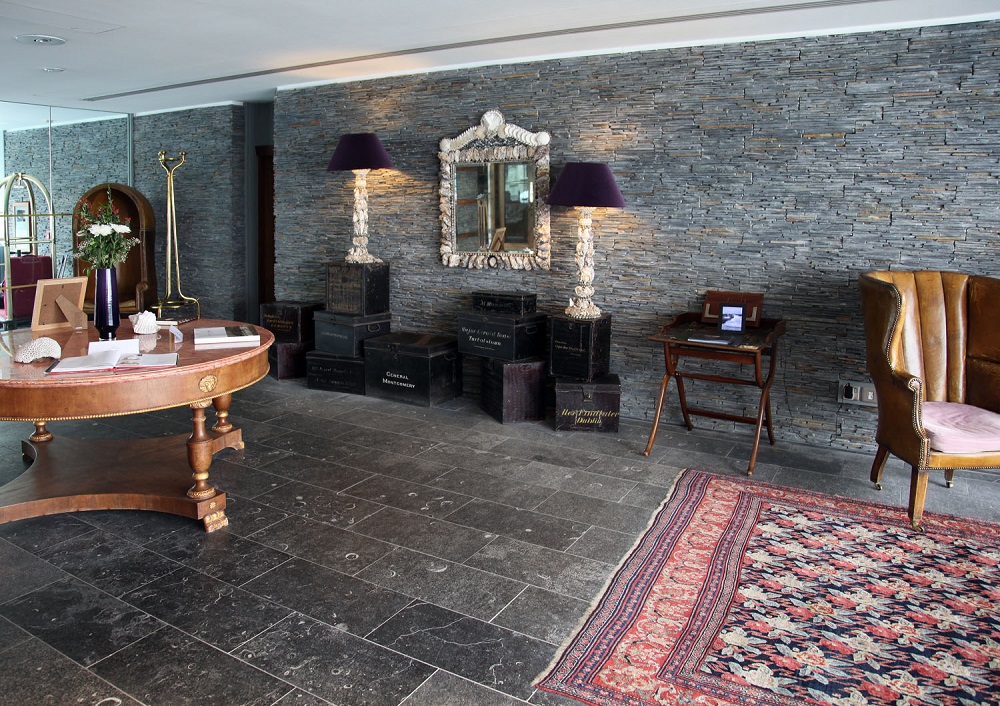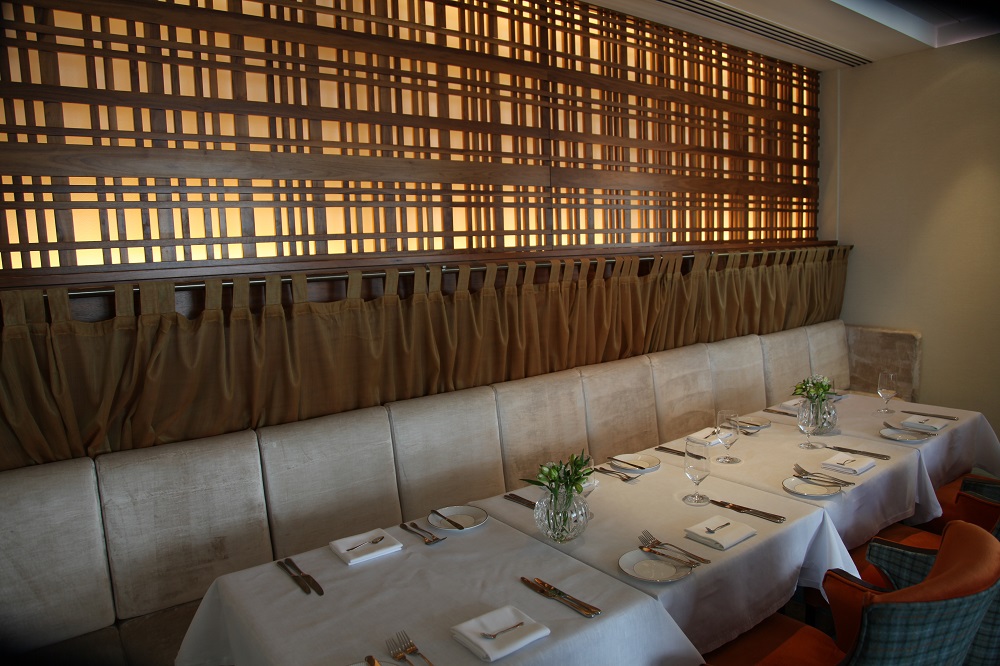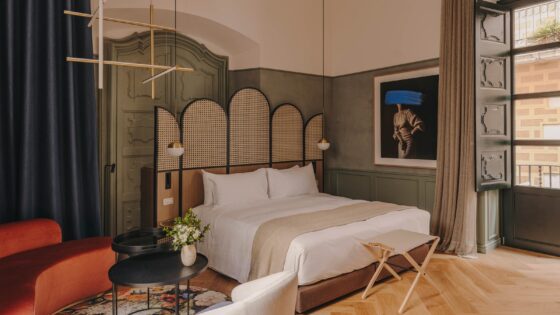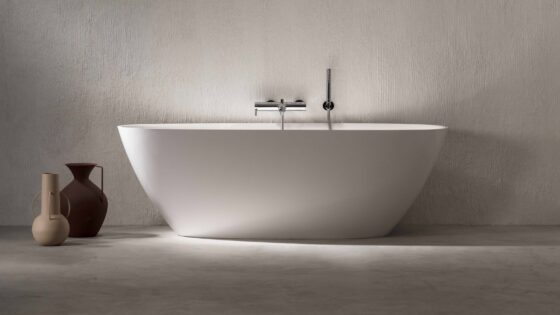The owner lives on the other side of the bay, looking on to his hotel, or at least the Victorian seaside hotel that was there. When he saw the proposed plans for its replacement, he didn’t like it. Refusing to spend his evenings looking at something unsightly, he bought the site and had Cliff House Hotel built. Wouldn’t we all do the same?
The result is a beautifully located stylish new five star hotel with architecture that spills down the hillside and cliffs, belying its seven floors with a roof line the same as the surrounding villas. Its location places the hotel in close contact with the sea. I was there in calm weather and I would imagine during a storm with high seas it must provide a wonderful experience. In calm weather it is possible to follow the path through the gardens to stand on the rocks and if the weather is warm enough, to even go swimming off them.
The link with the sea is followed through by the layout of the building which gives all the rooms sea views, some with seating areas in windows or on balconies overlooking the water. From across the bay, where the owner lives, the hotel is discrete. Interestingly, just a little further around the bay in which Ardmore is situated is a group of mobile homes, apparently places where rich Dubliners bring their families for the summer, giving the hotel large groups of ‘ladies that lunch’ to fill its bistro and Michelin starred restaurant.

During my trip to Ireland I saw many hotels that were in trouble – indeed NAMA, the Irish national ‘bad bank’ has nearly 100 of Irelands 900 odd hotels on its books (see articles). In the rotten economic climate Irelands bankers contributed to, it is all the more remarkable that the Cliff House became profitable in its third year and now in its fourth year it is becoming even more successful.
Part of the hotel’s success is its emphasis on service and the food offering, something enabled by the architecture which includes a greenhouse for the cook as well as a small garden area. Ireland is predominantly an agricultural nation and this hotel, unlike many, makes maximum use of local sourcing of both the produce from the land and the sea. It has a Michelin star for its restaurant but judging by difficulty in securing a table there, its bistro offering is enormously popular too.
The bar bistro shares a large terrace with the restaurant running along the sea front of the hotel, which more than doubles the available seating in summer and looks across the bay. Below the restaurant terrace are the gardens which provide intimate little ‘secret’ seating areas, but also hold part of the Spa which is on the floor below, with both the whirlpool bath and the seaweed treatment baths sitting out on their own terraces. Internally the bistro mixes formality and informality well. There is a comfortable seating area in front of an open fire and bar stools to the bar as well as more formal dining. Dining tables look out through the windows that fill one wall floor to ceiling maximising the view again.
The planning ensures that the kitchen and wine cellar service both the main restaurant and the bistro. The placing of all the service areas, delivery points and other non-guest areas on the rear, inland, side of the hotel ensures that guests enjoy continuous uninterrupted views of the sea from virtually everywhere they go in the hotel. It also preserves the striking architectural area that follows the cliff face down to the sea entirely for guests. The site planning has been meticulous and has served both hotelier and guest well.
Entering the hotel the guest is presented with a view to the sea immediately, looking right through the reception area. The reception area is part of a large atrium space which reaches from the top of the hotel to the restaurant floor, over three floors. On the top floor it forms a guest library lounge giving access to bedroom corridor. Here the lounges of suites are on the rear of the hotel but the suites all are over two floors with balconies off the bedrooms providing space for loungers and private dining as well as spectacular views.
The hotel interiors were done largely by the owners and they have amassed the largest collection of colonial campaign furniture in Ireland which are used as feature pieces throughout the hotel. However, it is the architecture and layout that are the strengths of the interiors. Colour is used cleverly throughout and reinforces the sense of movement through space, such as in the changing hues on the stair carpets, but always it is the views, changing light and sense of contact with the ocean that dominates. The duplex suites are a clever use of the space at the rear of the reception floor, making the guestroom lounges quiet to the rear and keeping the bedrooms with the views, adding deep terraces where dining and sun lounging in privacy are enabled.

The beds are positioned so that the view is seen easily through the large balcony access windows and the bathroom puts the shower in the window too, whilst bathrooms throughout deliver both shower and soaking tubs. The resulting glass walls flood the bathroom with light. This is the case with the glass wall in the bedroom too, but the blackout is effective at night. Rooms in the duplex are large and have their own dining and lounge areas. The campaign furniture works well in these, and specially commissioned artwork graces their internal staircases.
Interestingly the hotel has gone back to brass keys on large key fobs as they found the €8 cost of replacing the smart cards used in the electronic proximity locking system prohibitive as many guests still erroneously believe the cards encode personal details and take them away with them. The weight and presence of the brass keys leads to them being returned rather than remaining secreted in purses or wallets.
In the standard bedrooms there is variety of room layout and colour and all deliver a good sized desk (with free Wi-Fi of course), bay window with window seat or a fireplace, where on rainy days (and there are many in Ireland) guests can enjoy the views or relax without the temptations of the superb gourmet food experience the hotel offers. With all the bedrooms on the seaward side of the hotel, all guests are guaranteed a sea view. I was there in the summer, but a part of me wanted to stay during an Atlantic winter storm as the position of the hotel on the cliff edge must make this a spectacular experience for a guest – with the reassurance and comfort of Michelin food and wines and open fires in the public areas! The appeal of this hotel must, in part, be down to the ability to be on the large terraces in the sunshine and fresh air, but to retreat into comfortable internal spaces with all the cosseting by staff and service within seconds. This warm, encompassing, physical comfort is also a hallmark of the spa and leisure areas.
The entrance to the Spa and its reception are at the bottom of the spiral staircase that runs throughout the atrium. Here the space is internal, creating the initial calm controlled environment that every spa wants to exude on entry. From there it leads to the leisure and spa treatment areas.
The design of these areas then maximises the views of the ocean. Treadmills look out through picture windows to the sea. Similarly the pool has one end of glass to give clear views of the ocean. Treatment rooms, which need no daylight, are positioned to leave corridors with the views and the relaxation zone gives the couches different heights to view the ocean. Only here are there problems, with changing floor levels creating trip points marked out by hi-vis tape, a jarring note in an otherwise harmonious set of interiors.
As with the restaurants and bedrooms, the spa and leisure areas spill out onto the terraces with the spa pool and some treatment areas being places on sun-trap terraces. Despite their locations below most of the hotel it is surprising how private many of these areas are. Running below them all is the path through the gardens, again with secretive little areas for taking in the sun and views.
The hotel makes magnificent use of its location. The architectural layout has maximised the relationship with the sea. Location is more than just a seaside hotel in this instance, as Ardmore is a place of pilgrimage, being closely linked with the history of Christianity in Ireland. Within a few hundred metres are some of the earliest Christian sites, making the hotel visibility in the village a critical factor in how the architecture has been treated. Whilst visible from the water, the a fact that most of the site tumbles down the cliff means it has a low profile visually and a low roof line that all relate to the village cottages.
Communities are sensitive to large scale hotel developments which can sometime despoil a community. Here the 39 bedroom hotel has brought employment to the village and enhanced it as a destination, without being destructive visually. Maybe more hotels would benefit from the owner living with it in the vista from their houses…
Words and Pictures ©Patrick Goff. From a visit in August 2011








